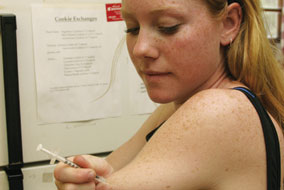
Lifespans for children with diabetes can be shortened by 15 years - photo courtesy of the Canadian Diabetes Association UBC Reports | Vol. 52 | No. 2 | Feb. 2, 2006
Diabetes Researchers Convert Viruses into Agents for Good
By Hilary Thomson
If you think all viruses are all bad, all the time, think again.
UBC diabetes researcher Timothy Kieffer is using the sometimes-lethal life form as a harmless courier to transport genetic information into a diseased pancreas -- information that can trigger regeneration and repair and may end the need for insulin injections.
Diabetes is caused by the inability of specialized cells of the pancreas, called beta cells, to produce sufficient amounts of insulin, a hormone critical for regulating blood sugar levels. Although causes are not entirely known, scientists believe the body’s own immune system destroys the insulin-producing beta cells in Type 1 or juvenile diabetes, and that the cells are present but dysfunctional in Type 2 or adult onset diabetes.
Termed an epidemic by the World Health Organization, diabetes currently affects about 177 million people worldwide, including two million Canadians and 18 million Americans. The health-care costs associated with diabetes are about $13 billion annually in Canada and $132 billion in the U.S. according to Canadian and U.S. diabetes associations.
Kieffer and Assistant Prof. Jim Johnson at UBC’s Life Sciences Institute, along with Assoc. Prof. Bruce Verchere and Assoc. Prof. Rusung Tan from the Child & Family Research Institute in Vancouver, have launched a five-year study to develop a viral vector, or carrier, that can deliver new genetic instructions to pancreatic beta cells. The gene therapy involves removing the virus’ own genetic blueprint and replacing it with genetic codes that can trigger growth of new beta cells and protect them from the immune system.
“Helping the body to regenerate its own cells would take us beyond treatment to a cure,” says Kieffer, who is an associate professor in the Depts. of Cellular and Physiological Sciences and Surgery.
The research group is one of only a handful of researchers worldwide looking at viral vectors as a tool to combat diabetes. Investigators have teamed up with gene therapist Paul D. Robbins, director of the University of Pittsburgh’s Viral Vector Core Facility, who is an expert in how genes can be transported to specific cell types.
The research, conducted in animal models, offers scientists the first tool to deliver therapeutic genes specifically to beta cells within the pancreas.
The team’s focus is Type 1 diabetes, which can be diagnosed from infancy to the late 30s. Patients must inject insulin several times every day.
“It’s heartbreaking to think that children as young as two or three have to do pinprick blood sugar checks up to a dozen times a day and use needles to deliver insulin for the rest of their lives,” says Kieffer. “Also, the life expectancy for these kids can be shortened by up to 15 years.”
Until now, scientists have been stumped by the problem of how to deliver genetic material directly and only to beta cells -- because the cells are few in number and scattered throughout the pancreas.
Viruses make excellent messengers because they can target particular cell types with great efficiency. They are also very effective at transferring their own genetic information into the host cell. By replacing the virus’ replication genes with genes that trigger beta cell regeneration, scientists can exploit the vectors’ natural ability to transfer genetic information to a specific target.
Additionally, vectors’ ability to hit specific targets means therapies would affect the pancreas only. Currently, to combat severe cases of diabetes, doctors can transplant clusters of beta cells -- called islets -- from donated organs. However, the entire immune system must be suppressed with potent drugs to stop it destroying the new beta cells. Targeted viral vectors may mean the ‘battle’ can be fought in the pancreas alone, without disrupting the body’s entire immune system.
Viral vectors also have the potential to help combat a variety of inherited and acquired illness, including cancer, infectious disease and atherosclerosis, or narrowing of the arteries.
Kieffer emphasizes that viral vectors are a tool, not a therapy, and estimates it will be at least 10 years before his research can be translated into therapies. The research may also help combat Type 2 diabetes.
Project funding of $300,000 annually comes from the Canadian Institutes of Health Research and the Juvenile Diabetes Research Foundation of Canada.For more information on diabetes, visit www.diabetes.ca. |
